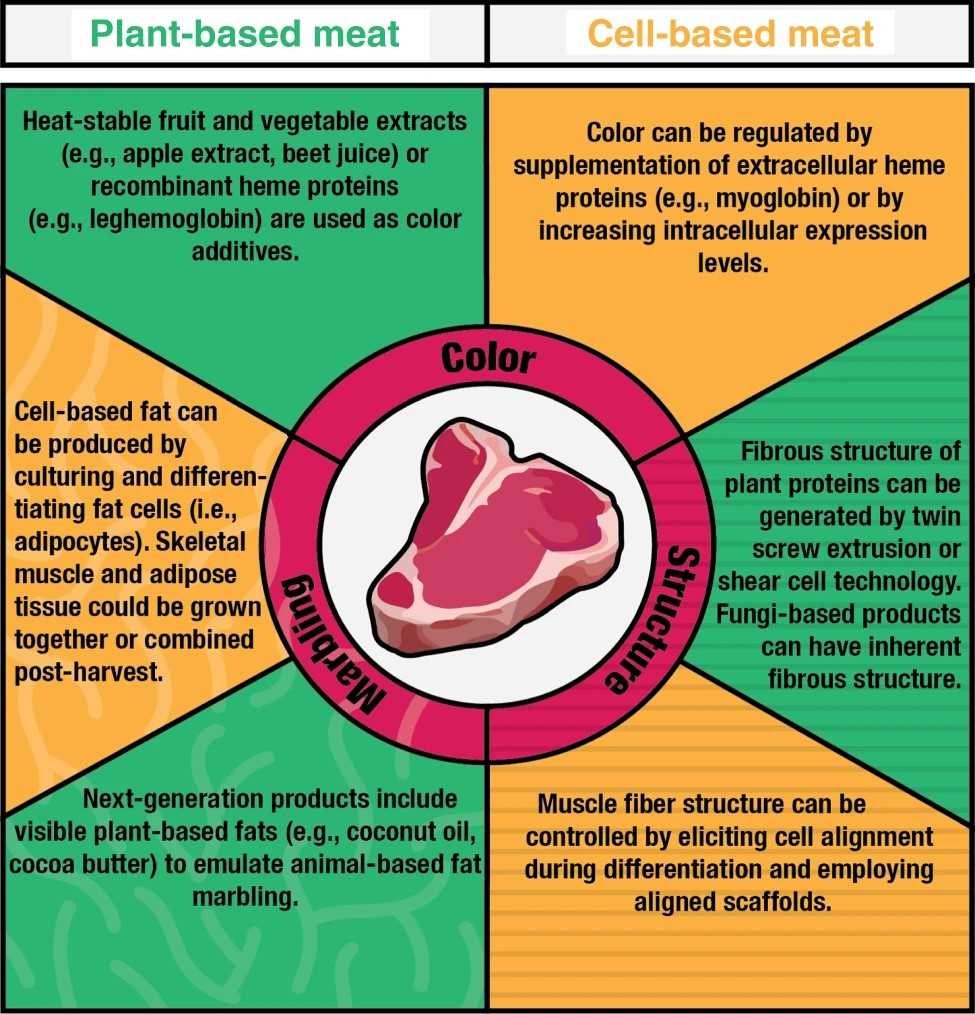Cultured meat represents an emerging trend to replace traditional animal meat for environmental and ethical reasons. Individuals have different views on cultured meat. Those familiar with cellular meat, or those educated about its environmental and health benefits, are more likely to embrace it. Consumer complaints are primarily about cultured meat safety and pricing, as well as uncertainties such as unnatural, unhealthy, unappealing tastes, and unexpected prices. Cultured meat aspires to be biologically equivalent to conventional meat. Sensory characteristics (texture, color, flavor) are critical if cultured meat is to be consumed. These sensory characteristics are derived from the molecular properties of the product, such as the content and nature of the protein, the presence of myoglobin, the composition of volatile compounds, etc. In addition to sensory characteristics, the nutritional quality of cultured meat should be as close as possible to its traditional counterpart.
 Fig.1. Plant-based and cell-based strategies for emulating appearance properties (color, marbling, structure) of meat. (Rubio N R, et al., 2020)
Fig.1. Plant-based and cell-based strategies for emulating appearance properties (color, marbling, structure) of meat. (Rubio N R, et al., 2020)
The main sensory characteristics of cultured meat are appearance, aroma, flavor, and texture. Cultured meat that lacks specific sensory properties can directly affect consumer acceptance and purchase behavior. As an ideal partner in the cultured meat sector, Lifeasible offers comprehensive solutions for improving the sensory properties of cultured meat.
We offer innovative scaffolding technologies to give cultured meat the texture of traditional meat. We have scaffolds based on cell culture and tissue engineering in many forms, including microcarriers, porous scaffolds, fiber scaffolds, hydrogels, and 3D bioprinting. In addition, collagen and gelatin can also be used as scaffolds for cultured meat.
The red color of meat is mainly attributed to the presence of myoglobin, a protein containing hemoglobin. We offer several ways to increase the myoglobin content of cultured meat.
❖ Adjusting culture conditions to increase myoglobin expression, for example, by culturing myofibrils under hypoxic conditions.
❖ Adding myoglobin directly to the culture medium.
❖ Adding myoglobin or other coloring agents externally later in the production process. This method is only suitable for processing cultured meat products. The attraction for our customers is the production of artificial pigmented soy hemoglobin by genetically engineered beech yeast.
We offer co-culture, media supplementation, and genetic modification to achieve key flavor profiles in cultured meats.
❖ Co-culture. We culture animal cells in the same petri dish as microalgae, which continue to grow and live by interacting closely with each other. The oxygen expelled by the microalgae is used by the mammalian cells, and, in turn, the microalgae use the mammalian metabolic waste for photosynthesis. This strategy allows further processing to obtain precise meat-like textures for a meat-like flavor.
❖ 3D tissue fabrication. We use co-culture systems to develop thicker cells with improved cellular damage, thus providing better texture during 3D manufacturing.
We adopt the following strategies to develop cultured meat with highly digestible proteins and an excellent amino acid composition, vitamins, and minerals.
❖ Selection of collagen, and fibrin polysaccharides as scaffolding material and as a source of dietary fiber.
❖ Adding essential fatty acids to the culture medium or adding vegetable fats to the cultured meat products.
❖ Adding vitamin B12 to cultured meat products.
(1) Processing.
(2) Application of additives.
(3) Selection of raw materials.
(4) New formula design.
The proteins and metabolites that give meat products their color, odor, and culinary properties are differentially expressed in cultured meat. Our goal is to add ingredients that contribute to the color, binding, and texture of cultured meat to assist food manufacturers in producing many delicious, compelling cultured types of meat. Our research team brings together faculty from the Department of Biological Sciences and the Department of Meat and Food Sciences to accelerate progress in these areas. Feel free to contact us for more information.
Reference